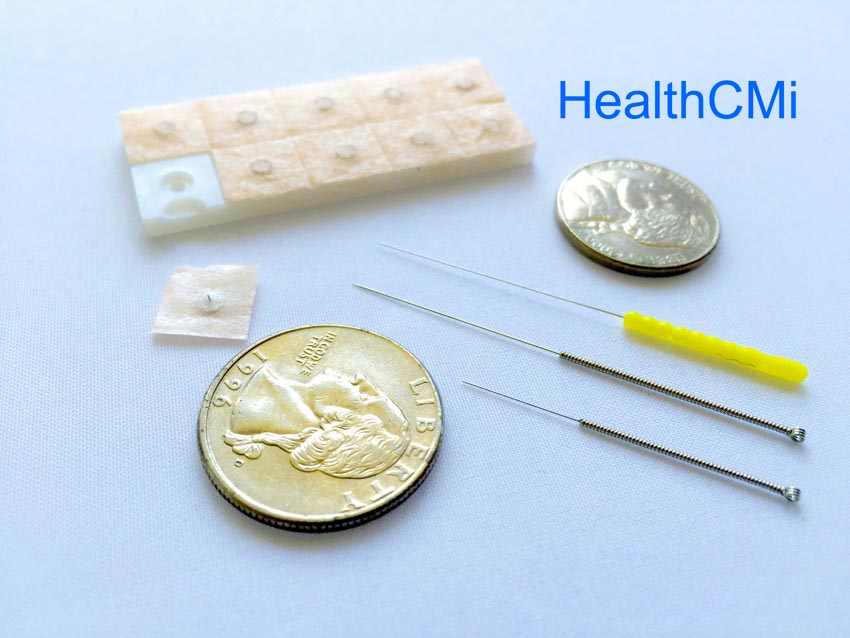
Heilongjiang University of Traditional Chinese Medicine researchers find acupuncture clinically effective for the treatment of progressive bulbar palsy, a disease that is a variant of amyotrophic lateral sclerosis (ALS). Progressive bulbar palsy is a rare illness involving the brain stem. Patients often have dysphagia (difficulty swallowing), weakness of facial and extremity muscles, loss of speech, and difficulty with chewing. In a controlled study of 90 patients receiving acupuncture treatments, researchers conclude that acupuncture has a 96.7% total effective rate for the treatment of bulbar palsy. In addition, 100% of all patients receiving acupuncture within two weeks of onset demonstrated significant improvements.
The effective rate for patients receiving acupuncture within 3–4 weeks of onset was 81.3%. In terms of different ages, 100% of patients under 60 years and 70.6% of patients over 60 years demonstrated significant clinical improvements. The results indicate that patients with progressive bulbar palsy benefit from acupuncture treatments.
Acupuncture is not a cure for the disease; however, the research demonstrates that acupuncture provides a significant level of relief when provided at earlier stages of the illness. The following were the acupuncture points used in the clinical trial:
- GB20 (Fengchi)
- EX-HN13 (Yiming)
- GV16 (Fengfu)
- CV23 (Lianquan)
- MHN20 (Jinjin)
- MHN20 (Yuye)
- Tunyan
- Gongxue
- Fayin
To clarify the proprietary acupuncture points mentioned above, Tunyan is an acupoint based on Prof. Gao Weibin’s experience. It is located 13 mm lateral to the midpoint of the laryngeal prominence (Adam's apple) and hyoid bone. A slanted insertion to a depth of approximately 8 mm was applied. Gongxue, another Prof. Gao Weibin point, is located 40 mm below GB20 (applied with a perpendicular insertion). Fayin is 5 mm lateral to the midpoint of thyroid cartilage and cricoid cartilage, applied with an 8 mm perpendicular insertion. The following acupoints were added for patients with central hemiplegia:
- TB5 (Waiguan)
- LI4 (Hegu)
- SI3 (Houxi)
- GB30 (Huantiao)
- ST36 (Zusanli)
- GB39 (Xuanzhong)
- GB43 (Xiaxi)
Routine disinfection with 75% alcohol was applied. Patients received acupuncture in the seated position. For Fengchi, Yiming, Gongxue, and Fengfu, 0.25 × 50 mm disposable filiform needles were transversely inserted to a depth of 25–40 mm. The twisting technique was applied for 15 seconds at a rate of 100 turns per minute. This was performed twice per session. Needles were retained for 30 minutes per acupuncture session after the application of manual needle stimulation.
For Jinjin and Yuye, 0.25 × 60 mm disposable filiform needles were transversely inserted to a depth of 40–50 mm and the needles were manipulated after insertion with twisting manipulation. Tunyan and Fayin were perpendicularly inserted to a depth of 8 mm with the same twisting manipulation. Treatment was administered two times per day, over a course of 6 days, and patients rested after each course. Researchers evaluated and documented the effects at the three week data point.
Supplements
According to the condition, researchers administered supplements to both the acupuncture experiment and control groups (e.g., Xue Sai Tong (containing panax notoginseng saponins), PAMBA (para-aminomethylbenzoic acid), mannitol, CDPC (cytidine diphosphate choline), compound Dan Shen tablets, compound antihypertensive tablets, aspirin, Vitamin C). The researchers note that the supplements were added based on the arteriosclerosis or blood pressure conditions. They were also added for improving microcirculation. This appears to be a weakness in the study design given the high rate of variability in the supplement protocol.
Treatment Effectiveness
The total treatment effective rates were 96.7% for the acupuncture experiment group and 46.7% for the control group. The treatment effective rates differ significantly between the two groups (P<0.005), reflecting that acupuncture is effective for the treatment of bulbar palsy. One-hundred percent of patients receiving acupuncture treatment within two weeks of onset had, at very least, slight or distinct improvements. A total of 81.3% of patients receiving acupuncture treatment within 3–4 weeks had, a least, slight or distinct improvements. Three out of the five patients receiving acupuncture within 5–12 weeks had a slight level of improvements.
The data shows the contrastive significance of those receiving acupuncture treatment within two weeks and four weeks (P<0.005). For age differences, researchers found that 100% patients under 60 years had some form of progress after acupuncture treatment and 70.6% patients over 60 years had progress after acupuncture treatment.
Discussion
The clinical improvements were greatest in patients that were younger and that received treatment shortly after diagnosis of the condition. This is a very pernicious disorder with no known cure; however, acupuncture is successful in ameliorating some of the symptoms. A study with stricter controls, a longer time-frame for treatment and follow-up, and a larger sample size will help to determine acupuncture’s place in a greater treatment protocol for patients with progressive bulbar palsy.
References
Gao WB, Sheng GB, Yao FZ Et al. Clinical observation of 90 cases of Bulbar Palsy treated with Acupuncture [J]. Chinese Acupuncture & Moxibustion, 2000, (3): 149 – 150.
Kang LR, Zheng S. Professor Gao Weibin's experience in the treatment of bulbar palsy [J]. Chinese Acupuncture & Moxibustion, 2016, 36(4): 402 – 404.
Zhang J, Liu YJ. Professor Gao Weibin's experience in the treatment of bulbar palsy [J]. Information on Traditional Chinese Medicine, 2012, 29(1): 71 – 73.


